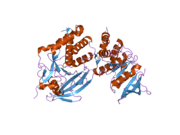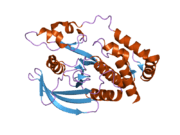PTPRG
| View/Edit Human | View/Edit Mouse |
Receptor-type tyrosine-protein phosphatase gamma is an enzyme that in humans is encoded by the PTPRG gene.[4][5]
The protein encoded by this gene is a member of the protein tyrosine phosphatase (PTP) family. PTPs are known to be signaling molecules that regulate a variety of cellular processes including cell growth, differentiation, mitotic cycle, and oncogenic transformation. This PTP possesses an extracellular region, a single transmembrane region, and two tandem intracytoplasmic catalytic domains, and thus represents a receptor-type PTP. The extracellular region of this PTP contains a carbonic anhydrase-like (CAH) domain, which is also found in the extracellular region of PTPRBETA/ZETA. This gene is located in a chromosomal region that is frequently deleted in renal cell carcinoma and lung carcinoma, thus is thought to be a candidate tumor suppressor gene.[5]
References
- ↑ "Diseases that are genetically associated with PTPRG view/edit references on wikidata".
- ↑ "Human PubMed Reference:".
- ↑ "Mouse PubMed Reference:".
- ↑ LaForgia S, Morse B, Levy J, Barnea G, Cannizzaro LA, Li F, Nowell PC, Boghosian-Sell L, Glick J, Weston A, et al. (Jul 1991). "Receptor protein-tyrosine phosphatase gamma is a candidate tumor suppressor gene at human chromosome region 3p21". Proc Natl Acad Sci U S A. 88 (11): 5036–40. doi:10.1073/pnas.88.11.5036. PMC 51802
 . PMID 1711217.
. PMID 1711217. - 1 2 "Entrez Gene: PTPRG protein tyrosine phosphatase, receptor type, G".
Further reading
- Kaplan R, Morse B, Huebner K, et al. (1990). "Cloning of three human tyrosine phosphatases reveals a multigene family of receptor-linked protein-tyrosine-phosphatases expressed in brain.". Proc. Natl. Acad. Sci. U.S.A. 87 (18): 7000–4. doi:10.1073/pnas.87.18.7000. PMC 54670
 . PMID 2169617.
. PMID 2169617. - Krueger NX, Streuli M, Saito H (1990). "Structural diversity and evolution of human receptor-like protein tyrosine phosphatases.". EMBO J. 9 (10): 3241–52. PMC 552056
 . PMID 2170109.
. PMID 2170109. - Latif F, Tory K, Modi W, et al. (1993). "A MspI polymorphism and linkage mapping of the human protein-tyrosine phosphatase G (PTPRG) gene.". Hum. Mol. Genet. 2 (1): 91. doi:10.1093/hmg/2.1.91. PMID 7683956.
- Barnea G, Silvennoinen O, Shaanan B, et al. (1993). "Identification of a carbonic anhydrase-like domain in the extracellular region of RPTP gamma defines a new subfamily of receptor tyrosine phosphatases.". Mol. Cell. Biol. 13 (3): 1497–506. PMC 359461
 . PMID 8382771.
. PMID 8382771. - Kastury K, Ohta M, Lasota J, et al. (1997). "Structure of the human receptor tyrosine phosphatase gamma gene (PTPRG) and relation to the familial RCC t(3;8) chromosome translocation.". Genomics. 32 (2): 225–35. doi:10.1006/geno.1996.0109. PMID 8833149.
- van Niekerk CC, Poels LG (1999). "Reduced expression of protein tyrosine phosphatase gamma in lung and ovarian tumors.". Cancer Lett. 137 (1): 61–73. doi:10.1016/S0304-3835(98)00344-9. PMID 10376795.
- Kawachi H, Tamura H, Watakabe I, et al. (1999). "Protein tyrosine phosphatase zeta/RPTPbeta interacts with PSD-95/SAP90 family.". Brain Res. Mol. Brain Res. 72 (1): 47–54. doi:10.1016/S0169-328X(99)00204-1. PMID 10521598.
- Liu S, Kulp SK, Sugimoto Y, et al. (2002). "Involvement of breast epithelial-stromal interactions in the regulation of protein tyrosine phosphatase-gamma (PTPgamma) mRNA expression by estrogenically active agents.". Breast Cancer Res. Treat. 71 (1): 21–35. doi:10.1023/A:1013343718942. PMID 11859871.
- Strausberg RL, Feingold EA, Grouse LH, et al. (2003). "Generation and initial analysis of more than 15,000 full-length human and mouse cDNA sequences.". Proc. Natl. Acad. Sci. U.S.A. 99 (26): 16899–903. doi:10.1073/pnas.242603899. PMC 139241
 . PMID 12477932.
. PMID 12477932. - Liu S, Sugimoto Y, Kulp SK, et al. (2003). "Estrogenic down-regulation of protein tyrosine phosphatase gamma (PTP gamma) in human breast is associated with estrogen receptor alpha.". Anticancer Res. 22 (6C): 3917–23. PMID 12553013.
- Liu S, Sugimoto Y, Sorio C, et al. (2004). "Function analysis of estrogenically regulated protein tyrosine phosphatase gamma (PTPgamma) in human breast cancer cell line MCF-7.". Oncogene. 23 (6): 1256–62. doi:10.1038/sj.onc.1207235. PMID 14676845.
- van Doorn R, Zoutman WH, Dijkman R, et al. (2005). "Epigenetic profiling of cutaneous T-cell lymphoma: promoter hypermethylation of multiple tumor suppressor genes including BCL7a, PTPRG, and p73.". J. Clin. Oncol. 23 (17): 3886–96. doi:10.1200/JCO.2005.11.353. PMID 15897551.
- Liu T, Qian WJ, Gritsenko MA, et al. (2006). "Human plasma N-glycoproteome analysis by immunoaffinity subtraction, hydrazide chemistry, and mass spectrometry.". J. Proteome Res. 4 (6): 2070–80. doi:10.1021/pr0502065. PMC 1850943
 . PMID 16335952.
. PMID 16335952.





